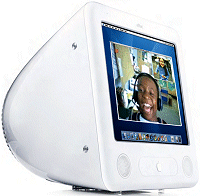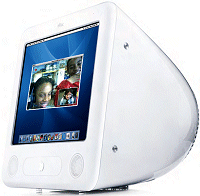Building Bridges With Video
##AUTHORSPLIT##<--->
A collaborative videoconferencing project succeeds in connecting two classroomsof students from opposite coasts—and opposite worlds.
 In the fall of 2004, Allisyn Levy and Craig Downing teamed up to implement a videoconferencing project that linked the students in Levy’s third-grade class at Public School 261 in Brooklyn, NY, with Downing’s third-graders at The Meridian School in Seattle. The two teachers were brought together by Mark Muzi, the parent of two children at The Meridian School and a member of the school’s board of directors, who pitched Allisyn and Craig the idea of using Apple Computer’s video-enabled iChat instant messaging application in their classrooms after using the technology in his work as a University of Washington cancer researcher to stay in contact with colleagues remotely. Levy, a former Meridian School teacher who had moved east a few years earlier, and Downing loved the idea, and so the program was launched, connecting students acrossa continent, and across racial and economic divides.
In the fall of 2004, Allisyn Levy and Craig Downing teamed up to implement a videoconferencing project that linked the students in Levy’s third-grade class at Public School 261 in Brooklyn, NY, with Downing’s third-graders at The Meridian School in Seattle. The two teachers were brought together by Mark Muzi, the parent of two children at The Meridian School and a member of the school’s board of directors, who pitched Allisyn and Craig the idea of using Apple Computer’s video-enabled iChat instant messaging application in their classrooms after using the technology in his work as a University of Washington cancer researcher to stay in contact with colleagues remotely. Levy, a former Meridian School teacher who had moved east a few years earlier, and Downing loved the idea, and so the program was launched, connecting students acrossa continent, and across racial and economic divides.
At the outset, rather than establishing lofty curricular goals, we were motivated by the chance to link two schools in vastly different settings, with students from disparate backgrounds. The Meridian School is a private school set in a spacious pastoral area in Seattle’s Wallingford neighborhood, and it serves about 175 predominantly Caucasian students from middle- and upper-middle-income families. Meanwhile, New York City’s Public School 261 has an entirely different profile. PS 261 is situated in the ethnically and economically diverse Boerum Hill neighborhood of Brooklyn, with a mostly African-American and Hispanic student population of roughly 80. The two schools are separated not only by distance and student composition, but by educational mission and the distinctly different patterns of suburban and urban life.
Beyond merely facilitating conventional pen palling through letter writing or e-mail, the iChat@School program, as Mark Muzi named it, would be a way to visually interact with another student at another location.“Video pals,” we called it.
With Mark’s help, we were able to get the project off the ground within a few months of conceiving it. Some technical bugs had to be overcome, but both participating schools had the minimum requirements for videoconferencing—Mac OS X (with built-in video instant messaging), an eMac, and a high-speed internet connection. The only hardware lacking on both ends was a video camera. Problem solved with Mark’s generous purchase of two iSight video cameras ($150 each), which plug right in to the eMacs. A software program called Conference Recorder, from Ecamm Network, was also added, enabling us to record and save the video sessions for sharing with families and reflecting on the project.
Once the technology was in place, the first iChat hookup was made, linking two third-graders named Jake. Both kids were awestruck by the technology, staring at the video window in disbelief. Brooklyn Jake broke the ice, saying, “It’s weird that we have the same name.” Seattle Jake agreed. As the school year went on, the student interactions continued— generally once or twice a week, usually one-on-one, but sometimes involving pairs of students. We had accomplished what we had originally set out to do: create connections between children of different circumstances in different locations. But the potential of videoconferencing spawned many ideas on enriching classroom goals. We turned the chats into interview sessions in which each video pal would ask the other questions such as “What’s it like in New York?” and “What is your favorite animal and why?” This taught the students how to conduct an interview and how to formulate effective questions for eliciting specific and general responses. Allowing the kids to create their own questions generated far more interesting outcomes, such as this doozy: “I heard there are a lot of rats in New York. Is this true?”
The kids enjoyed the conferencing experience so much that they complainedwhen a field trip to a chocolate factory conflicted with their video pal time.
As the program moved into its second year, we continued to explore more ways videoconferencing could enhance learning. One thing we did was to have our students take notes on their video pals’ responses while they conducted their interviews. Following the sessions, the students would make formal presentations to their classmates about their iChat partners. This process not only improved note-taking and public- speaking skills, it also produced insightful classroom discussions as students considered the similarities and differences they discovered during their conversations.
Additionally, the students read poems they had written, either to their video pals or to the entire class on the other end, and received feedback. This offered a new exchange of ideas, as well as gave the kids further public-speaking experience. Interestingly, the videoconferencing opened up normally timid students, who would shy away from speaking in front of their classmates. With iChat acting as middleman, those same students showed no fear.
The most ambitious attempt at integrating videoconferencing came when the Seattle classroom invited the Brooklyn students to take part in the performance of its class play. The PS 261 kids were needed to play the part of a stolen piece of artwork, and those who wanted to auditioned for the role via video. Unfortunately, the effort couldn’t be completed. A live iChat segment during the performance of The Meridian School production was attempted, but timezone differences and scheduling challenges prevented it.
Moving Ahead
 Initially, we wanted to get some experience using videoconferencing in the classroom, connect students from different environments, and advance communication skills. Now, with the project entering its third year, we want to integrate videoconferencing into the curriculum.
Initially, we wanted to get some experience using videoconferencing in the classroom, connect students from different environments, and advance communication skills. Now, with the project entering its third year, we want to integrate videoconferencing into the curriculum.
Certainly, the program has been a big hit with students thus far. “It was exciting that we got to talk to people that we never knew before,” says Samira, a Brooklyn student. “The kids we talked to were polite, and we got to learn about them, like the sports they like to play.” The Seattle kids enjoyed the experience so much that they actually complained when a field trip to a chocolate factory conflicted with their video pal time.
Since launching the program, we have discovered that videoconferencing provides an authentic way for students to strive to be proficient communicators while engaging in different cultural experiences. We can’t afford to take students on trips across the world, but we can use technology to bring global interactions into the classroom.
Allisyn Levy teaches at Public School 261 in Brooklyn, NY. CraigDowning teaches at The Meridian School, a private elementaryschool in Seattle.
This article originally appeared in the 01/01/2007 issue of THE Journal.